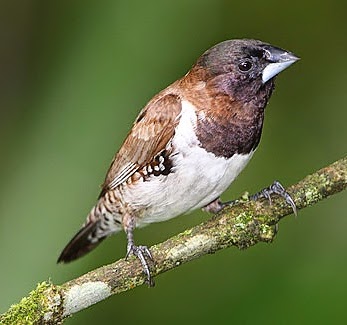 |
| Photo by Warwick Tarboton (Warwick Tarboton) |
Common name:
bronze munia (en); bico-de-chumbo-bronzeado (pt); capucin nonnette (fr); capuchino bronceado (es); kleinelsterchen (de)
Taxonomy:
Order Passeriformes
Family Estrildidae
Range:
This species is found in sub-Saharan Africa, from Senegal east to Ethiopia and south to Angola, eastern Botswana and eastern South Africa. There is also an introduced population in Puerto Rico.
Size:
These birds are 9-10 cm long and weigh 10-12 g.
Habitat:
The bronze munia is found in tropical forests and savannas, dry scrublands, dry grasslands, inland wetlands such as marshes and swamps, and also in pastures and arable land.
Diet:
They forage on the ground or in low vegetation, mainly taking grass seeds and cultivated cereals such as rice. They also take some insects, such as termites and ants, and occasionally nectar.
Breeding:
Bronze munias can breed all year round. The nest is built by both sexes, consisting of a domed structure made of grasses and lined with feather and soft plant fibres, placed in a small tree 2-3 m above the ground. It is usually located near wasp on ant nests. The female lays 4-8 eggs which are incubated by both parents for 12-14 days. The chicks fledge 17-21 days after hatching but only become fully independent 3 weeks later. Each pair can raise multiple broods per year.
Conservation:
IUCN status – LC (Least Concern)
This species has a very large breeding range and is described as common and widespread. The population is suspected to be stable in the absence of evidence for any declines or substantial threats.







